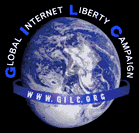
GILC Submission on PICS December 1997
We, the undersigned members of the Global Internet Liberty Campaign (GILC), make the following submission in relation to the W3C Proposed Recommendation "PICSRules 1.1" dated 4 November 1997 (http://www.w3.org/TR/PR-PICSRules.htm).
GILC members are concerned with matters of human rights, civil liberty, and personal freedom.
Noting that:
- Article 19 of the Universal Declaration of Human Rights explicitly protects freedom of expression for all and specifically the "freedom to hold opinions without interference and to seek, receive and impart information and ideas through any media".
- This principle has been reaffirmed in multiple international agreements, including the International Covenant on Civil and Political Rights.
- W3C's mission is "to realize the full potential of the Web: as an elegant machine-to-machine system, as a compelling human-to-computer interface, and as an efficient human-human communications medium".
- PICSRules 1.1 have been developed for, or can be used for, the purposes of:
- preventing individuals from using the Internet to exchange information on topics that may be controversial or unpopular,
- enabling the development of country profiles to facilitate a global/universal rating system desired by governments,
- blocking access to content on entire domains, via the specification of full or partial domain names and/or IP addresses, regardless of the username, port number, or particular file path that is specified in the URL,
- blocking access to Internet content available at any domain or page which contains a specific key-word or character string in the URL,
- over-riding self-rating labels provided by content creators and providers.
- PICSRules 1.1 go far beyond the original objective of PICS to empower Internet users to control what they and those under their care access. They further facilitate the implementation of server/ proxy-based filtering thus providing a more simplified means of enabling upstream censorship, beyond the control of the end user.
We draw to W3C's attention that:
- similar techniques that block Internet sites have prevented access to innocuous speech, either by deliberate intent, through oversight, or as a result of ignorance of the infrastructure of the Web,
- repressive governments are desirous of a more easily implementable, technological, means of restricting information their citizens are able to access and inhibiting their communications with others,
- methods to restrict the ability of citizens to gain access to information and to communicate with others are contrary to principles of free expression and democratic society,
- PICSRules 1.1, in enabling the use of wildcards in IP addresses, etc, facilitate blocking of not only entire domains, but of the majority of content originating from specified countries,
- the rapidly increasing number of people accessing the Web discredits the perception, of various government and industry representatives, that limitations on content accessibility are essential to provide a climate of confidence for the furtherance of electronic commerce. In fact, filtering and rating systems intended for the protection of minors have proven inefficient and counter-productive,
- the ability of community organisations to develop a ratings system applicable to their values, a stated original intent of PICS, is not enhanced by the complex, albeit sophisticated, language of PICSRules 1.1.
Whilst the W3C media release of 25 November 1997 states that:
"PICSRules is a mechanism for exchanging user settings, resulting in an easy one-click configuration...With PICSRules parents can go to a PTA site and download initial settings which are recommended for primary school children..."
even a cursory analysis of PICSRules 1.1 indicates that the likelihood of community organisations developing complex profiles is slim. The necessary expertise is more likely to be acquired by governments seeking to restrict access to content and inhibit freedom of expression.
PICSRules 1.1 are clearly intended to serve the purpose of enabling the empowered to restrict the ability of the unempowered to communicate.
It seems apparent that PICSRules have been developed in response to calls from governments who seek a more efficient and effective technological means of restricting human-to-human communications. European and Australian governments, at the least, are involved in the development of a global rating system which will be enabled by PICSRules 1.1. Mandatory labelling of content has already been proposed in the UK, Australia, USA. The ability of governments to restrict access and freedom of expression through the use of firewalls /proxies will be enhanced by the adoption of PICSRules 1.1.
In view of the above, we oppose the proposed adoption of PICSRules 1.1 on the grounds that they will provide a tool for widespread global censorship, which will conflict with W3C's mission to "realize the full potential of the Web...as an efficient human-human communications medium".
We call on W3C to reject the proposals of the PICSRules Working Group and direct resources towards working on genuine metadata systems which will facilitate easier and faster access to desired classes of information by all Internet users, rather than solely supporting denial of access.
Background:
American Civil Liberties Union (ACLU) (USA):
"Fahrenheit 451.2: Is Cyberspace Burning? -- How Rating and Blocking Proposals May Torch Free Speech on the Internet" (http://www.aclu.org/issues/cyber/burning.html)Computer Professionals for Social Responsibility (CPSR) (USA):
"Filtering FAQ" (http://quark.cpsr.org/~harryh/faq.html)Cyber-Rights & Cyber-Liberties (UK):
"Who watches the Watchmen: Internet Content Rating Systems, and Privatised Censorship" (http://www.leeds.ac.uk/law/pgs/yaman/watchmen.htm)Electronic Privacy Information Center (USA):
"Faulty Filters: How Content Filters Block Access to Kid-Friendly Information on the Internet" (http://www2.epic.org/reports/filter-report.html)Imaginons un Reseau Internet Solidaire (IRIS) (F):
"Labeling and Filtering: Possibilities, Dangers, and Perspectives" (http://girafe.ensba.fr/iris/rapport-ce/annexe6.html)This submission is made by the following organisations:
Associazione per la Libertà nella Comunicazione Elettronica Interattiva (ALCEI)
http://www.nexus.it/alcei.htmlAmerican Civil Liberties Union
http://www.aclu.org/Bulgarian Institute for Legal Development
http://www.bild.acad.bg/CommUnity - The Computer Communicators Association
http://www.community.org.uk/Computer Professionals for Social Responsibility
http://www.cpsr.org/home.htmlCyber-Rights & Cyber-Liberties (UK)
http://www.leeds.ac.uk/law/pgs/yaman/yaman.htmDerechos Human Rights
http://www.derechos.org/Electronic Frontiers Australia
http://www.efa.org.au/Electronic Frontier Foundation
http://www.eff.orgElectronic Privacy Information Center
http://www.epic.org/FITUG e.V. Foerderkreis Informationstechnik und Gesellschaft
http://www.fitug.de/Fronteras Electrónicas España (FrEE)
http://www.arnal.es/freeHuman Rights Watch
http://www.hrw.org/Imaginons un Reseau Internet Solidaire
http://girafe.ensba.fr/iris/NetAction
http://www.netaction.org/Peacefire
http://www.peacefire.org/Privacy International
http://www.privacy.org/pi/quintessenz
http://www.quintessenz.at/entrance/index.html